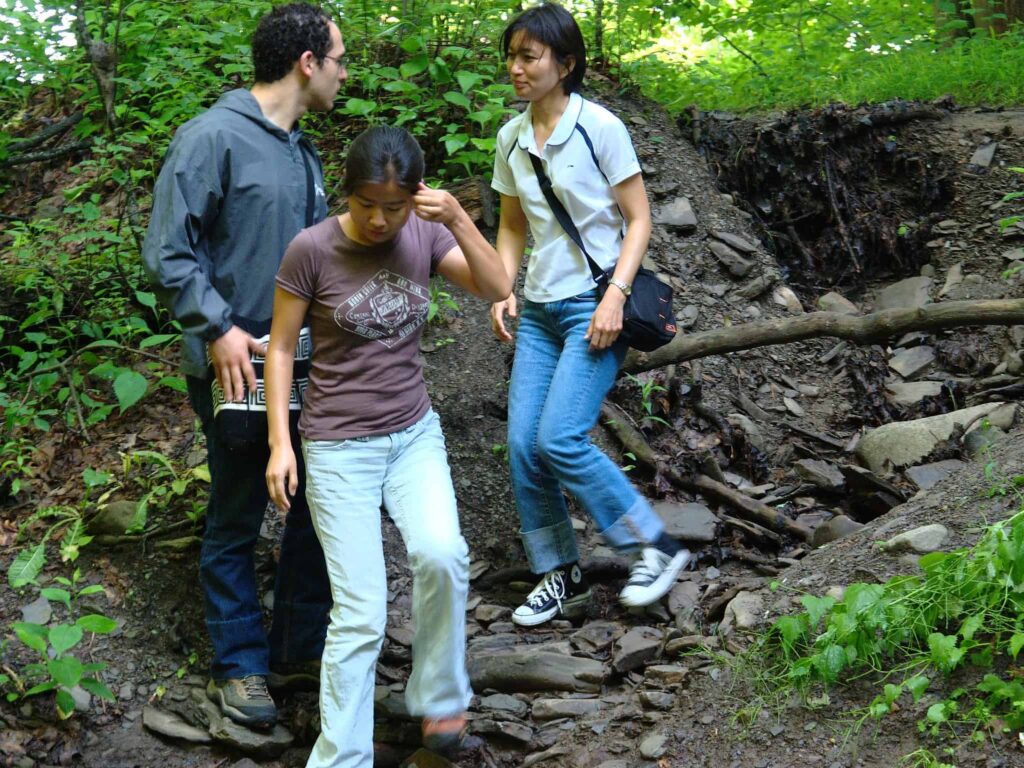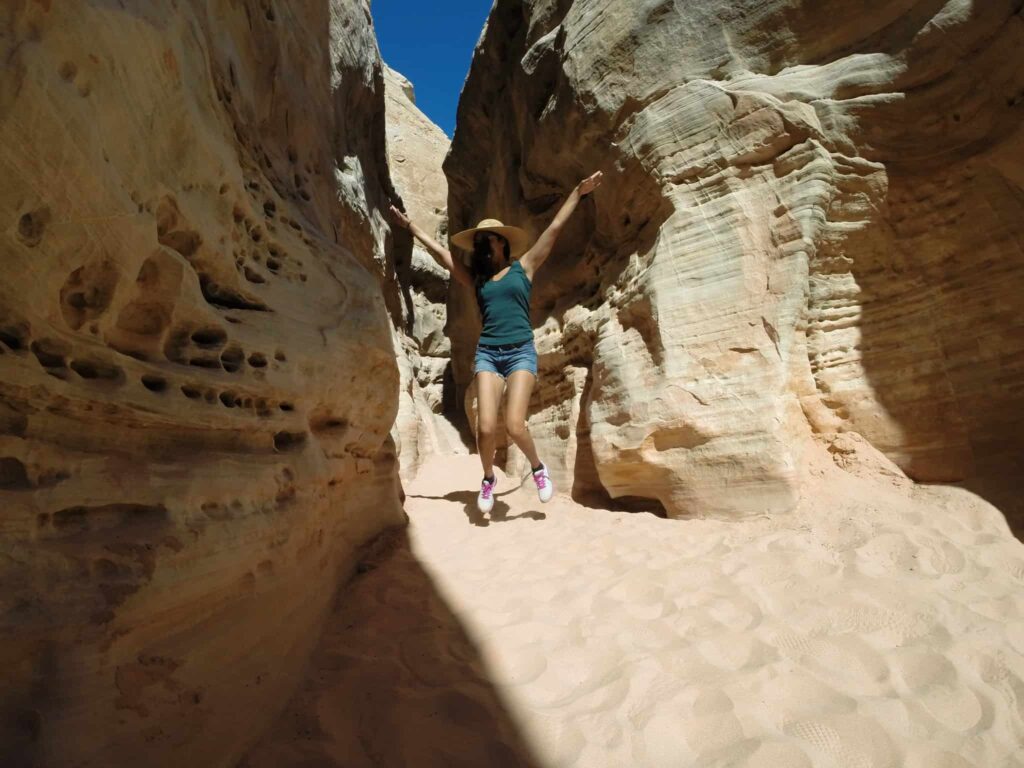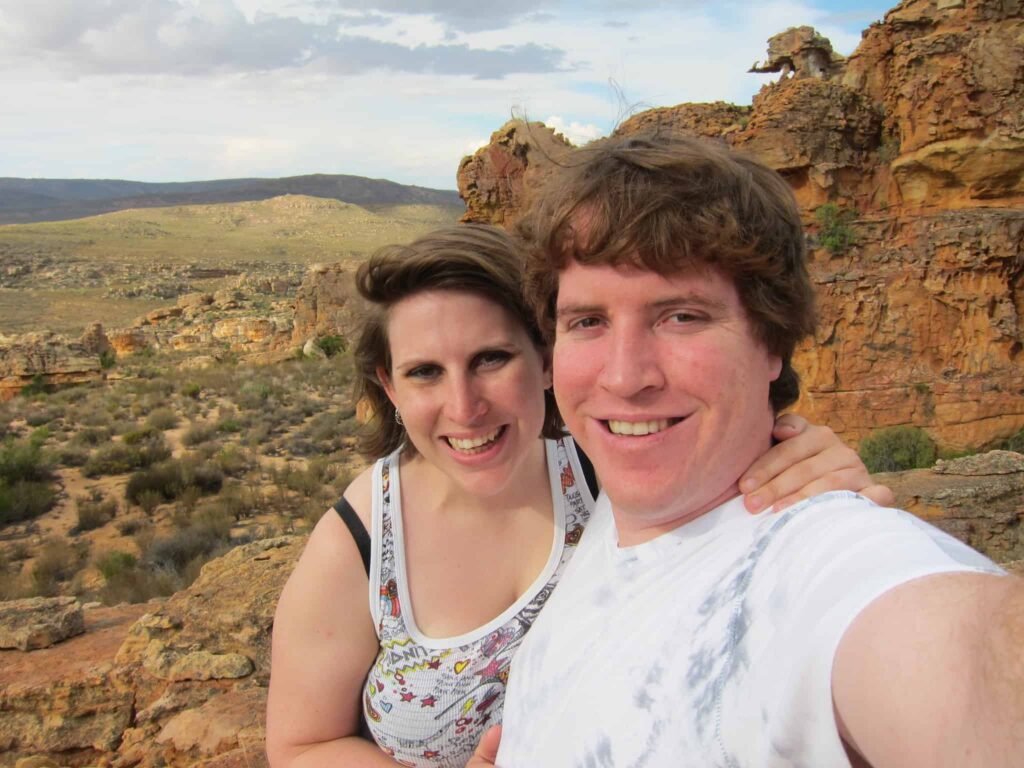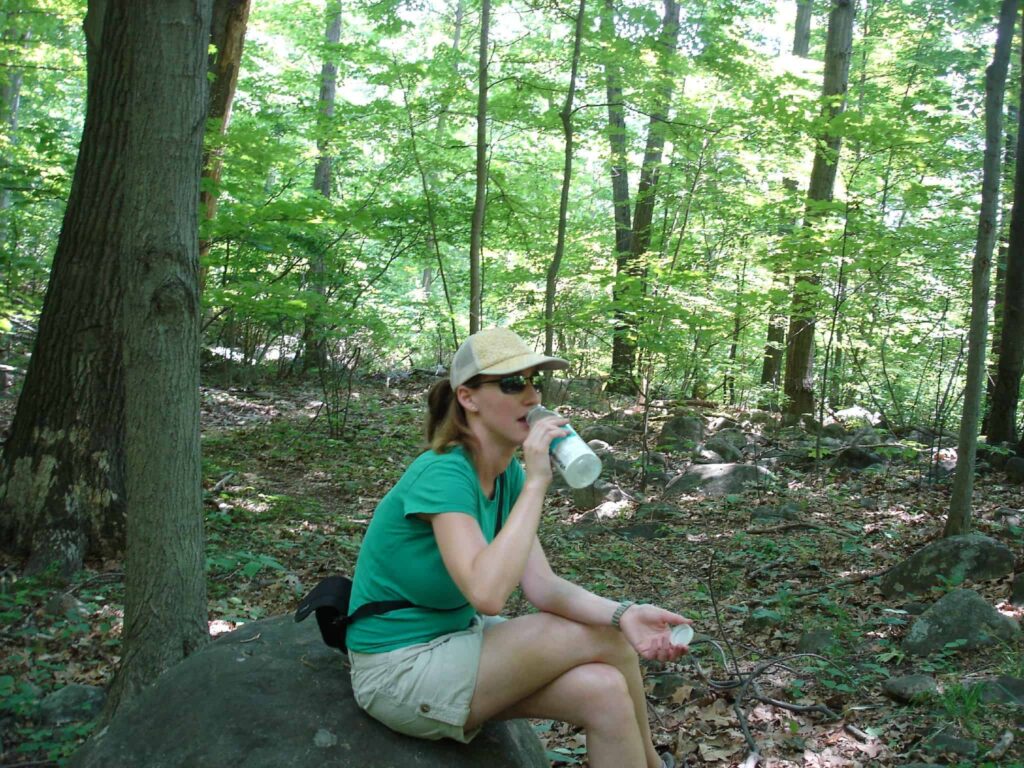Last updated on February 13th, 2023 at 04:33 pm
Anyone who’s ever experienced chafing understands how painful it is. Not only does it burn during activity, it can create raised rashes and even bleeding that stick around for days. Learning how to prevent chafing while hiking is essential for protecting your skin and enjoying your hike or camping experience.
You can prevent chafing by adjusting your pack weight and ensuring it fits correctly, wearing the right clothes, preparing beforehand, and staying hydrated.
1) Pack Light
We all know chaffing hurts, and it can be a real turn-off to hiking. One of the most common factors for chafing on the arms and neck is a pack that’s either too heavy or poorly fitted.
Overweight packs increase the pressure on the shoulders.
For instance, the more the weight the more the friction. And with more friction, there’s and increase irritation to the skin.
Throw in a little sweat, and you’ve got a pack that unrelentingly digs and rubs into your flesh all day. The result is excruciating.
However, one simple solution is to pack less or pack lighter.
But of course, we know that’s easier said than done. Especially since heavier items tend to cost less in the backpacking world. The phrase, ‘the more you pay, the less you weigh’ is very much the reality.
Therefore, it’s beneficial to evaluate your pack items and your budget to see where you can shave off pounds.

Areas where you can reduce pack weight:
- Sleeping bags. Down sleeping bags weigh much less and are much smaller than synthetic sleeping bags. However, they also cost substantially more.
- Clothing. Clothing specially designed for hiking is much lighter weight to pack. While hiking clothes cost more, they are much lighter and wick moisture better. Even if you purchase one piece of clothing at a time, it eventually adds up to the best hiking experience.
- Water Bottles. Avoid insulated or stainless steel water bottles or an excessive amount of water. Water is heavy. If you can filter water with a filter straw rather than carry it, it’s a better alternative. Water filters aren’t overly expensive.
- Food. Dehydrated food is the lightest, but requires water to hydrate. A general rule is to keep your food supply under 2 lbs. per day so you don’t overpack. If you’re worried about calories, focus on carb-heavy, dense food bars to supplement your needs.
- Toys & Trinkets. It’s always tempting to bring extra gear that you don’t need, especially electronics and camp amenities. It’s always best to be a minimalist when hiking. So if you don’t need it, leave it at home.
- Tents. When backpacking, every ounce matters. Tents add a lot of weight to your pack, but ultra-light tents are also super expensive. Choose the lightest possible version you can afford.
- Medkits. First aid kits cater to multiple people. Consider taking just the important items for yourself. For example, tapes, moleskin, clippers, bandaids, chapstick, etc. Remove any extra items you generally won’t use without sacrificing your level of safety.
- Backpack. Try a lighter, smaller backpack to save on weight. Choosing a bag around 55 liters helps you reduce a good amount of weight. It also helps you become more conscious about the weight you’re carrying with you.
2) Wear Dry Clothes
Additionally, your clothes play a large part in your comfort. The weather can change on any given day. It’s especially important to dress the part. Choosing the right clothes not only protects you from the elements, but it also prevents chafing.
Clothing that’s breathable, moisture-wicking, and quick drying are paramount to prevent chafing.
Polyester and nylon are popular choices, but silk and wool are also good options.
The more you sweat, the more apt you are to chafe, and the more irritated your skin becomes. Staying dry on the trail requires proper clothing.
Many outdoor clothing brands use blends of nylon and spandex to provide a little give in the material. This keeps you both dry and comfortable.
Additionally, a good pair of waterproof hiking boots will help eliminate the potential to chafe on your heels and instep. We’ve found the best options in our Best Waterproof Hiking Boots for Men post.
We prepare for everyhike with these few simple steps in mind. And, by doing so, there’s time to enjoy the scenery with our favorite hiking binoculars found in our Best Lightweight Hiking Binoculars post.
3) Don’t Wear Cotton
Importantly, cotton is something you should never wear out on the trail.
Cotton absorbs moisture and doesn’t dry well.
The result is that it adds weight to your already heavy load and primes your skin for irritation.
It also doesn’t do well at regulating body temperatures, which can be problematic in cold conditions. In fact, it can lead to rapid loss of body heat and contribute to hypothermia.
Any outdoor enthusiast can tell you the detrimental effects of cotton. It can literally be the difference between life and death.
From a chafing standpoint, wearing wet clothes continuously is super irritating to the skin. Because cotton doesn’t dry quickly, it’s one of the worst things you can wear for any outdoor adventure.
This is particularly important when it comes to undergarments. Chafing is much like a diaper rash.
Furthermore, the wetness from the material combined with the salt from sweating can be aggressively irritating to the skin.
For this reason, you should always avoid cotton panties, underwear, or bras.

4) Opt for Synthetic Materials
Moreover, synthetic materials are by far the best choice for hiking. As already mentioned, they’re lighter, more breathable, moisture-wicking, and quick drying.
For good protection around the thighs, try a moisture-wicking mesh, neoprene compression gear, or a microfiber blend. All of these reduce friction in hot zones for friction like inner thighs.
Additionally, the stitching on a garment can sometimes be the culprit to irritating the skin. Opting for seamless and zero-tag clothing can assist in reducing chafing.
5) Avoid Baggy Clothes
Also, baggy clothes are also notorious for contributing to chafing. Sometimes they bunch up in sensitive areas like the armpits, groin areas, and nipples.
Alternatively, they constantly rub on your skin while you walk. After a prolonged period of rubbing, the skin eventually becomes raw and irritated. If you’ve ever seen runners with Band-Aids covering their nipples, now you know why.
In addition, shorts that are too long and baggy, for example, can cause severe chafing. By continually rubbing the back of your legs over long periods of time, they can eventually rub your skin raw. Choosing properly fitted attire is absolutely necessary when hiking and backpacking.
Hikers and gym rats don’t wear skin tight pants and shirts to show off their bodies. Chafing is a real problem that almost every active person deals with.

6) Lubricate Pre-Hike
Some campers like to lubricate sensitive areas before heading out for a hike. In fact, there are even a variety of commercial products on the market designed to heal and protect the skin.
Cocoa Butter
Using cocoa butter for medicinal purposes dates back to the days of the Aztecs and Mayans. It has a long history of healing skin wounds.
Cocoa butter absorbs extremely well and does an excellent job at protecting, healing, and keeping the skin hydrated. It’s extremely useful for restoring water content to the skin and aiding its recovery as well as reducing friction.
A word of caution, however, on using cocoa butter in the wilderness. Depending on your environment, you may attract some uninvited and unwanted wildlife.
If we’re just day hiking on a marked trail, I might dab a bit on certain hot spots. However, if there’s any overnight camping involved with my hiking, I resort to Option B (vaseline).
I’m personally not a big fan of Cocoa Butter on the trail when sleeping in the wilderness. Don’t risk attracting bees or bears with cocoa butter in, say, a national park.
Vaseline (petroleum jelly)
Or, applying a moderate amount of Vaseline or other protective ointments to prone areas can help prevent chafing.
Petroleum jelly lubricates the skin, reduces friction, and provides a waterproof protective coating.
While Vaseline is a protective agent, it does not absorb into the skin very well. Some herbal versions contain other oils that absorb better and assist with healing.
However, petroleum jelly is a great failsafe for chafe prevention.
Additionally, protective ointments, like Neosporin, contain Vitamin E, help reduce inflammation, and protect skin from infection as well.
Body Glide Sticks
Commercial products such as anti-chafing sticks are often long-lasting and water resistant.
Our favorites are Squirrel’s Nut Butter and Bodyglide, which use a combination of oils and beeswax.
These options also reduce friction, penetrate, and heal the skin. Meanwhile, the beeswax creates a waterproof protective barrier to prevent it from washing off.
7) Secure Your Pack
Ill-fitted or poorly adjusted packs can also contribute to irritation of the skin. Sometimes unforgiving straps can wreak havoc by creating unrelenting pressure on one part of the body.
Ensuring that your gear is packed correctly is the first step. It’s also important to make sure your pack is properly fitted to your body.
Ensure you can wear your pack without any undue pressure on the shoulders, back, or hips. Your shoulder straps should be snug so they don’t slide back and forth with every step.
If your pack is bouncing and shifting, you’re guaranteed to get some chafing hotspots. It’s important to ensure your pack fits well.
If you have a framed pack, sometimes you may feel uncomfortable pressure around the hip area. Perhaps the waist belt is unpliable, or the frame rests directly on your hip bone.
These are all areas that you should investigate before purchasing your pack.
However, if you find yourself wearing an uncomfortable pack, there are hacks to help you prevent chafing to some degree.
Lube or tape under pressure points to reduce the friction in those areas.
You can also add some padding to your pack to soften the rub and attempt to make it less uncomfortable.
Ideally, your pack should fit snug without being too tight, but also without sliding all over the place.

8) Bandage Pre-Hike
As we all know, certain parts of the body are predisposed to chafing. Of primary concern are the shoulders, hips and lower back, as well as the groin and inner thighs.
It’s also not uncommon to have chaffing around the nipples, around your butt cheeks, or in the underarm area.
If you have enough experience to know where your sensitive areas are, be proactive by bandaging them ahead of time.
For example, I’m prone to chafing near the underarm area where my pack strap rubs against my arm. I use a couple of pieces of precut hypoallergenic leukotape where the strap interacts with my skin.
Then I cover that with a couple of pieces of sports tape or moleskin, depending on what I have available. This could also be done to the nipple and hip areas as well.
For larger areas like the thighs, some hikers prefer to use kinesiology tape or K-tape.
Adding a protective barrier between your skin and whatever is irritating it is the best way to prevent chafing altogether.
9) Absorb Moisture with Cornstarch
Alternatively, for hard-to-reach places where tape may not be ideal, cornstarch is an excellent tool. This is a great option for the groin area, butt cheeks, and underarm area.
Cornstarch has been used for years by truckers, heavy-set athletes, and hikers alike. It was the original diaper rash remedy of yesteryear and is still one of the best-kept secrets to date.
Unbeknownst to many, cornstarch contains an abundance of healthy vitamins and minerals. Rich in Vitamin A, B1, B2, zinc, calcium, and iron, cornstarch soothes the skin and helps regenerate healthy skin cells.
Not only is it effective and inexpensive, cornstarch greatly reduces friction from skin-to-skin and skin-to-clothing contact, while also absorbing moisture.
Not only does it form a protective barrier over the skin, but it also stimulates cell regeneration.

10) Wear Spandex Shorts
Spandex does wonders for eliminating chafing around the thighs and groin area. Garment made of this material are breathable and wick moisture, keeping you dry. The material is soft and stretches, but fits snug so it’s comfortable. plus, it stays put and provides a barrier against friction.
Spandex comes in a variety of forms and options, so find one that fits your style and comfort level.
You can choose from slip shorts, compression shorts, or high-performance shorts just to name a few.
Spandex is an ideal way to get rid of any hot spots in your groin area or thighs.
I wear spandex shorts almost every day, whether it’s under dresses, for a bike ride, or for a 20 mile hike. They really have saved my thighs and keep me feeling good and ready for the next adventure. Plus, they look a lot less weird than k-tape sticky to your legs, especially if you’re heading into town.
11) Stay Hydrated
Finally, staying hydrated goes a long way to preventing chafing.
When you become dehydrated, your body emits more salt when you sweat and your skin becomes drier.
Drier skin facilitates increased friction and the additional salt increases skin aggravation.
By staying hydrated and drinking lots of water, you lower the salt content of your sweat.
This, in turn, lessens friction in those vulnerable areas.
Additionally, an abundance of fluid running through your body greatly assists in keeping your skin moisturized and elastic.
A good way to stay hydrated is to drink at least one to two cups of water before your hike.
Then drink at least one quart of water each hour.
Drinking fluids with carbohydrates and electrolytes at least once or twice a day can help you retain fluids better. Plus, it helps maintain energy levels.
Continue drinking even after you stop hiking for the day, especially if you’re on a multiday hike. Be sure to eat something with sodium and potassium with your evening meal. Foods like bananas, avocado, beans, spinach, and dried fruit are high in potassium.
And, rehydrating in the evening will ensure that you’re ready for the next day’s adventure.

A Comfortable Hike is on the Horizon
Chafing is an extremely unpleasant experience that almost every hiker has dealt with at least once. However, knowing how to adequately prepare will ensure that you can enjoy your trail experience.
Don’t be afraid to mix and match these remedies for ultimate chafing prevention. Because having a chafe-free hike not only lets you enjoy the experience more, but makes you want to do it again. We hope you find relief with this advice, and we wish you many happy hikes!
About the Author
Sarah Sampsell
Title Image Credit, How to Prevent Chafing While Hiking: GlacierNPS | (source) | Public Domain Mark 1.0 — reduced file size and image
Image Credit 1, How to Prevent Chafing While Hiking: Adam Bautz | (source) | Attribution 2.0 Generic (CC BY 2.0) — reduced file size and image
Image Credit 2, How to Prevent Chafing While Hiking: Carl Mueller | (source) | Attribution 2.0 Generic (CC BY 2.0) — reduced file size and image
How to Prevent Chafing While Hiking, Image Credit 3: Adam Bautz | (source) | Attribution 2.0 Generic (CC BY 2.0) — reduced file size and image
How to Prevent Chafing While Hiking, Image Credit 4: Amy Truter | (source) | Attribution 2.0 Generic (CC BY 2.0) — reduced file size and image
Image Credit 5, How to Prevent Chafing While Hiking: Sean Hagen | (source) | Attribution-ShareAlike 2.0 Generic (CC BY-SA 2.0) — reduced file size and image
Image Credit 6, How to Prevent Chafing While Hiking: Henry | (source) | Attribution-ShareAlike 2.0 Generic (CC BY-SA 2.0) — reduced file size and image

